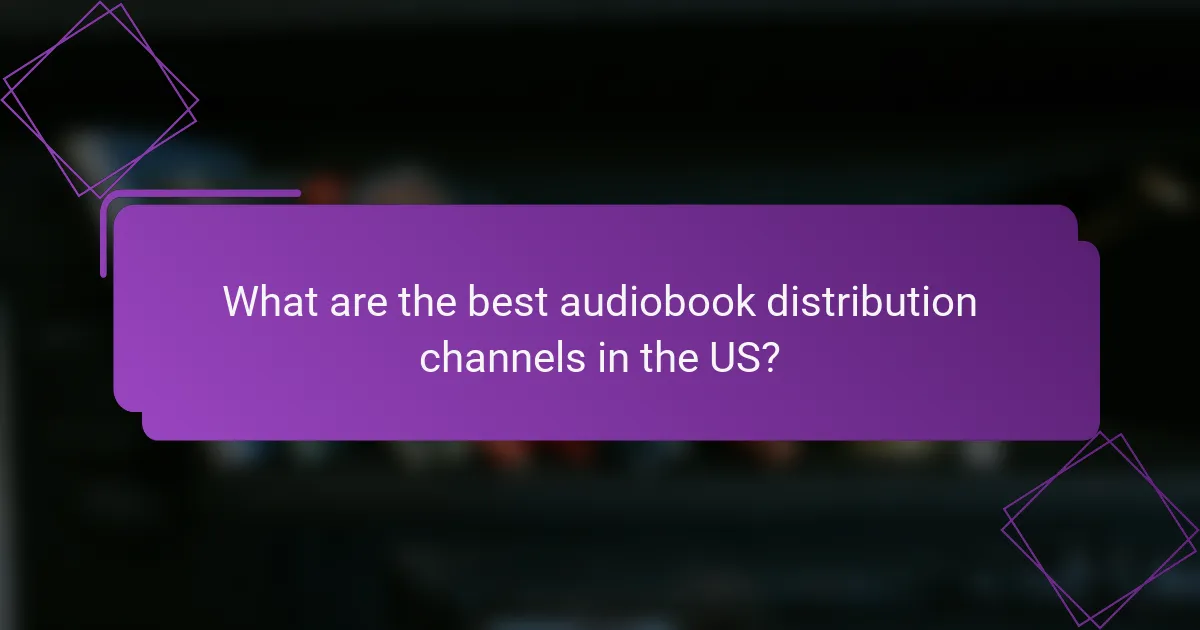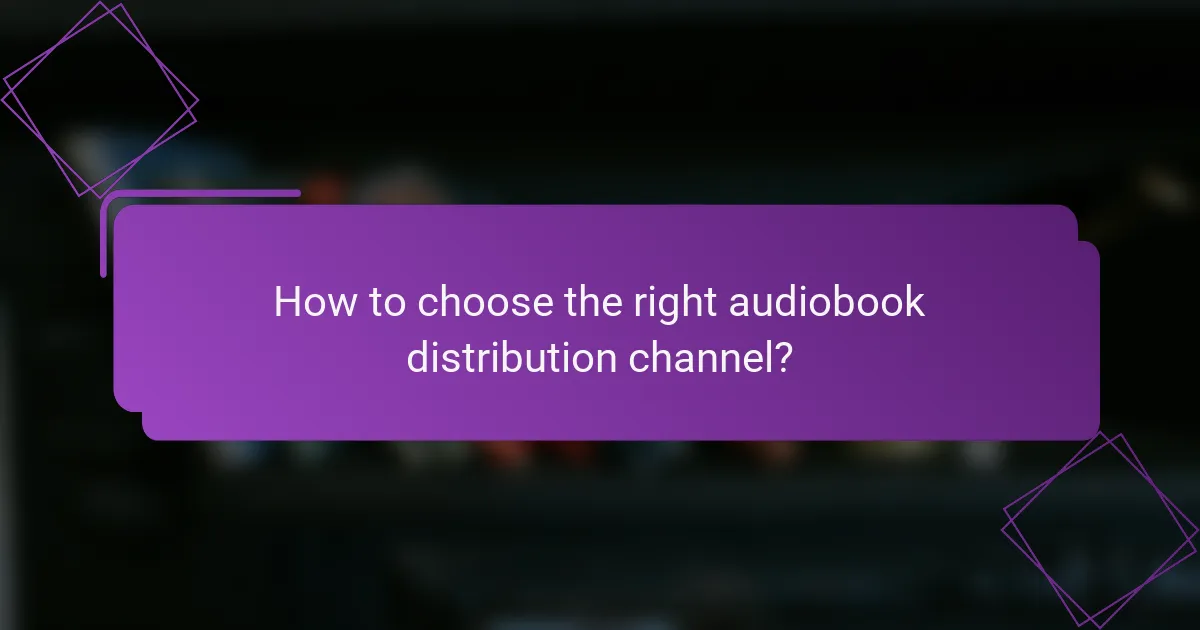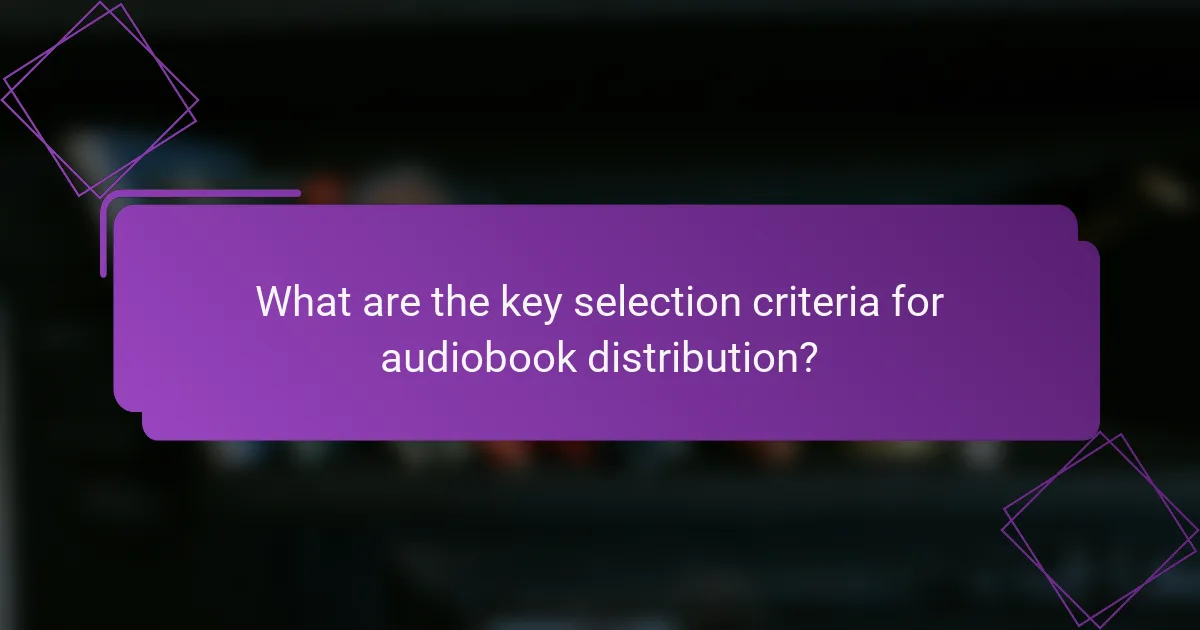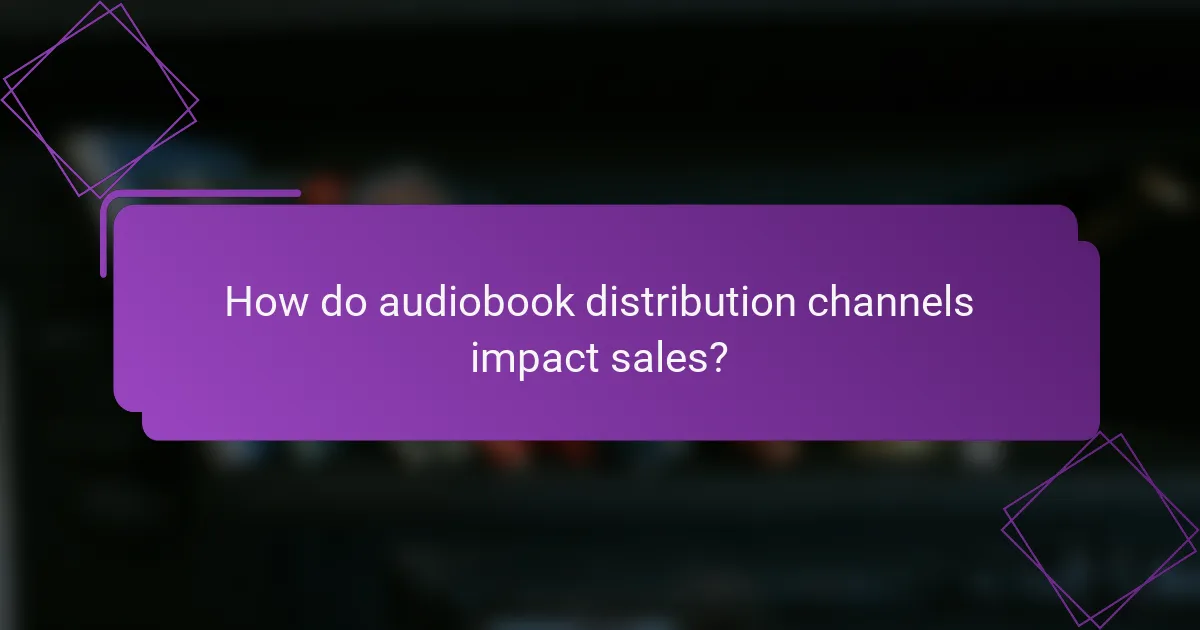Choosing the right audiobook distribution channel is essential for authors and publishers looking to maximize their reach and revenue. Key platforms such as Audible, Apple Books, and Google Play Books each offer unique benefits, making it important to consider factors like audience reach, royalty rates, and marketing support. By leveraging multiple channels, creators can enhance visibility and tap into diverse revenue opportunities.

What are the best audiobook distribution channels in the US?
The best audiobook distribution channels in the US include platforms that maximize reach and revenue for authors and publishers. Key options are Audible, Apple Books, Kobo, Scribd, and Google Play Books, each offering unique benefits and considerations.
Audible
Audible is one of the largest and most recognized audiobook platforms in the US, known for its extensive library and subscription model. Authors can distribute their audiobooks through Audible via ACX (Audiobook Creation Exchange), which allows for direct sales and royalties based on listener subscriptions.
Consider the competitive nature of Audible, as it requires quality production and marketing efforts to stand out. Authors typically earn between 25% to 40% royalties depending on their distribution choices.
Apple Books
Apple Books offers a robust platform for audiobook distribution, allowing authors to reach a large audience of Apple device users. Audiobooks can be uploaded directly through Apple’s platform, providing a straightforward sales process.
Royalties on Apple Books typically range from 70% for books priced above a certain threshold. It’s crucial to ensure your audiobook meets Apple’s quality standards to avoid rejection during the submission process.
Kobo
Kobo is a popular choice for independent authors, especially in the US and Canada. Their audiobook service is integrated with their eBook platform, allowing for cross-promotion between formats.
Authors can expect around 70% royalties on sales, making it an attractive option. However, Kobo’s audiobook library is smaller compared to Audible, which may limit exposure.
Scribd
Scribd operates on a subscription model, providing access to a wide range of audiobooks, eBooks, and documents. Authors can distribute their audiobooks through Scribd, gaining access to a diverse audience.
Royalties on Scribd can vary, but they often depend on the number of times a book is read or listened to. This model can be beneficial for authors whose works attract high engagement.
Google Play Books
Google Play Books allows authors to distribute audiobooks to Android users and those using Google services. The platform supports a variety of formats and offers a straightforward upload process.
Royalties on Google Play Books are typically around 70%, similar to Apple Books. Authors should be aware of the need for proper formatting and metadata to enhance discoverability on the platform.

How to choose the right audiobook distribution channel?
Selecting the right audiobook distribution channel is crucial for maximizing your reach and revenue. Consider factors such as audience reach, royalty rates, platform compatibility, and marketing support to make an informed decision.
Consider audience reach
Audience reach refers to the potential number of listeners your audiobook can attract through a distribution channel. Look for platforms with a large user base, as this can significantly enhance your visibility and sales.
Popular platforms like Audible and Google Play have millions of active users, while niche sites may cater to specific genres or demographics. Balancing broad reach with targeted audiences can optimize your distribution strategy.
Evaluate royalty rates
Royalty rates determine how much you earn from each sale, making it essential to compare different channels. Most platforms offer royalty rates ranging from 25% to 50% of the sale price, with some variations based on exclusivity agreements.
For instance, Audible typically offers a higher rate for exclusive titles, while non-exclusive agreements may yield lower earnings. Carefully assess the trade-offs between higher royalties and broader distribution options.
Assess platform compatibility
Platform compatibility involves how well your audiobook format aligns with the distribution channel’s requirements. Ensure your audio files meet the technical specifications, such as file type and quality standards.
Some platforms may require specific formats like MP3 or AAC, while others might have unique metadata requirements. Familiarize yourself with these details to avoid delays in publishing your audiobook.
Review marketing support
Marketing support can significantly impact your audiobook’s success. Some distribution channels offer promotional tools, advertising options, or featured placements to help boost visibility.
Investigate what marketing resources each platform provides, such as social media promotions or email marketing campaigns. Channels that actively promote your work can lead to higher sales and audience engagement.

What are the benefits of using multiple audiobook distribution channels?
Using multiple audiobook distribution channels enhances your reach and maximizes potential sales. By diversifying where your audiobooks are available, you can tap into different audiences and revenue opportunities.
Increased visibility
Multiple distribution channels increase the visibility of your audiobooks, making them accessible to a wider audience. When your titles are available on various platforms, they are more likely to appear in search results and recommendations, attracting more listeners.
Consider platforms like Audible, Google Play, and Apple Books. Each has its own user base and promotional strategies, which can significantly enhance your audiobook’s exposure.
Diverse revenue streams
Utilizing various distribution channels allows you to create diverse revenue streams, reducing reliance on any single source. This can lead to increased overall earnings, as different platforms may offer distinct pricing models or promotional opportunities.
For example, some platforms may allow you to set your own prices, while others may offer subscription models. By understanding these differences, you can optimize your pricing strategy across channels.
Broader audience engagement
Engaging a broader audience becomes easier with multiple distribution channels, as each platform attracts different demographics. This diversity can help you reach niche markets that may not be accessible through a single channel.
For instance, younger audiences might prefer platforms like Spotify, while older listeners may gravitate towards traditional retailers. Tailoring your marketing efforts to each platform can enhance engagement and listener loyalty.

What are the key selection criteria for audiobook distribution?
When selecting an audiobook distribution channel, consider factors such as distribution fees, payment terms, and sales reporting. These criteria significantly impact your revenue and overall success in reaching your target audience.
Distribution fees
Distribution fees refer to the costs associated with using a particular platform to distribute your audiobook. These fees can vary widely, typically ranging from 10% to 30% of your sales revenue. It’s essential to compare different platforms to find one that aligns with your budget and sales expectations.
Some platforms may charge upfront fees or offer a pay-as-you-go model, while others might take a percentage of your royalties. Evaluate these options based on your sales projections and financial goals to make an informed decision.
Payment terms
Payment terms dictate how and when you receive your earnings from audiobook sales. Most platforms operate on a monthly or quarterly payment schedule, with some requiring a minimum threshold before issuing payments. Understanding these terms is crucial for managing your cash flow effectively.
Additionally, be aware of any delays in payments due to processing times or returns. Choose a distribution channel that offers transparent and favorable payment terms to ensure timely access to your earnings.
Sales reporting
Sales reporting provides insights into how your audiobook is performing across different platforms. Look for distribution channels that offer detailed reporting features, including sales numbers, listener demographics, and trends over time. This data is invaluable for refining your marketing strategies and understanding your audience.
Regular access to sales reports can help you identify which titles are performing well and which may need additional promotion. Opt for platforms that provide real-time or frequent updates to keep you informed about your audiobook’s performance.

How do audiobook distribution channels impact sales?
Audiobook distribution channels significantly influence sales by determining how and where listeners can access titles. Choosing the right channels can enhance visibility, reach specific audiences, and ultimately drive revenue.
Channel-specific marketing
Effective marketing strategies vary by distribution channel, as each platform attracts different listener demographics. For instance, platforms like Audible may require targeted promotions that highlight exclusive content, while libraries might benefit from community outreach and partnerships.
Utilizing social media and email marketing tailored to each channel can also enhance engagement. Consider creating promotional campaigns that leverage the unique features of each platform, such as Audible’s membership discounts or library programs that encourage borrowing.
Sales performance metrics
Monitoring sales performance metrics is crucial for evaluating the effectiveness of your chosen distribution channels. Key metrics include conversion rates, listener retention, and average sales per channel, which can provide insights into what works best.
Regularly analyze these metrics to identify trends and adjust your strategies accordingly. For example, if a particular channel shows lower sales, consider reallocating resources or enhancing marketing efforts in that area to boost performance.

What are the emerging trends in audiobook distribution?
Emerging trends in audiobook distribution focus on the rise of subscription models, increased use of digital platforms, and the growing demand for diverse content. These trends are reshaping how audiobooks reach consumers and how creators monetize their work.
Growth of subscription models
Subscription models for audiobooks are becoming increasingly popular, allowing users to access a vast library of titles for a monthly fee. Services like Audible and Scribd offer unlimited listening options, which appeal to avid readers and casual listeners alike.
These models often provide a free trial period, encouraging new users to explore the platform without commitment. However, it’s essential for authors and publishers to consider the revenue-sharing structure, as it may differ significantly from traditional sales.
When selecting a subscription service, evaluate factors such as audience reach, royalty rates, and marketing support. Balancing these elements can help maximize visibility and profitability in a competitive market.


